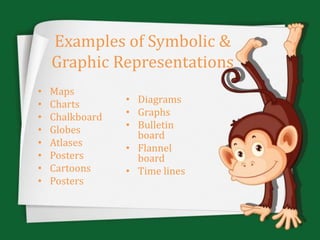Instructional Materials & Technology Used in Teaching
- 1. INSTRUCTIONAL MATERIALS/TECHNOLOGY By John Patrick C. Villena & Jewel Jem J. Beren
- 3. HIGH ACHIEVERS VS. SLOW LEARNERS Secondary Level Primary Level
- 4. WHAT ARE INSTRUCTIONAL MATERIALS? Educational Resource Delivery Vehicles Improves Students’ knowledge Gives color to the learning process
- 5. WHY IS IT IMPORTANT? Increases the effectiveness of the teacher Stimulate interest Clarify the subject matter Help make learning more permanent
- 7. Guidelines for Using Instructional Aids Purpose Define Objectives Flexibility Diversity Development Content Guide Learners Evaluate Results
- 8. DIFFERENT TYPES OF INSTRUCTIONAL AIDS & TEACHING AIDS
- 9. PRINTED MATERIALS • Written in text, prepared and published commercially • Type of educational material used by most teachers
- 10. Examples of Printed Materials are: • Textbooks • Workbooks • Magazines • Newspapers • Reference books • Other types of books
- 11. Supplemental Materials • Sometimes called Instructional Aids or Pedagogical Aids • Materials designed for teacher use that are provided as supplements to the text books. Examples are: • Teacher’s Manuals • Test Questions • Skills books or Exercise books • Transparencies • Bulletin Boards • Teacher resource binders • Lesson Plans
- 13. Sounds and Visual Resources • Taught by the use of other sensory organs (hearing & seeing) • Makes it more easier to learn • Presented by the use of technology
- 14. Under the S&V Resources are: • Films • Projectors • Televisions • Video Tapes • Cassette Tapes • DVD’s, VCD’s, CD’s • VHS • Radio • Tape Recorders
- 17. PICTURES & PICTORIAL REPRESENTATIVES • Shown in order to present the learners what something looks like • Makes it easier for them to learn what something looks like, instead of mentally visualizing and imagining the lesson on the subject matter
- 18. Examples of Pictorial Representatives • photographs • drawings • slides • transparencies • still pictures • post cards • study prints • albums • scrap books • collages • murals • videos • story boards
- 20. SYMBOLIC AND GRAPHIC RESPRESENTATION • Materials used for making learners understand a topic thoroughly by use of symbols, legends, graphs, etc.
- 21. Examples of Symbolic & Graphic Representations • Maps • Charts • Chalkboard • Globes • Atlases • Posters • Cartoons • Posters • Diagrams • Graphs • Bulletin board • Flannel board • Time lines
- 22. MICROCOMPUTER RESOURCES • Resources made with modern technology • Makes teacher’s and learner’s jobs easier
- 23. Examples of Microcomputer Resources • Hardware • Printer • Graphics tablet • Voice synthesizer • Software • Modem • Trackball • Mouse • Networks • Scanner • Joystick • Touch window
- 24. Printer Scanner























